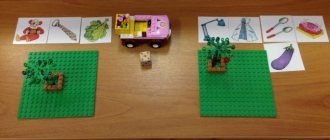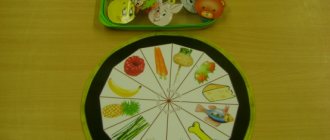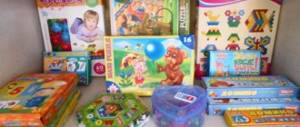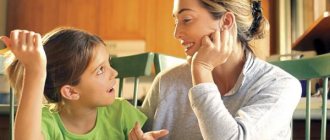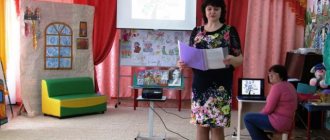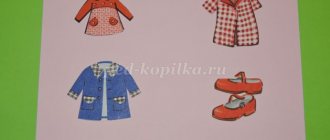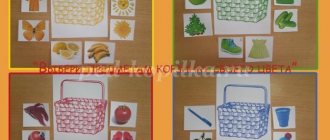Card index of games based on fairy tales
Progress of the game:
A fairy tale is chosen for adults (this may be a fairy tale that is currently being studied). The presenter takes one of the heroes of the fairy tale and describes him: he tells how he looks, good or evil, big or small, what he does during the fairy tale, etc. After that, he asks the children to repeat what he said.
Then the presenter takes another figurine and asks the children to take turns describing the hero and make sure that the descriptions are not repeated.
If this does not work, the presenter asks leading questions: for example, what is the grandfather wearing; is he old or young; what he does, etc. For correct answers, the child receives a token. The one who gives the most answers wins.
"Find by silhouette."
Purpose of the game: Development of speech, visual thinking, attention, figurative memory.
Material: figures of heroes from one fairy tale are used (“Turnip”, “Teremok”, “Kolobok”, “Hare and Fox (Zayushkina’s hut)”, etc.). You can use figurines of fairy-tale characters from the theater on flannelgraph.
Progress of the game:
The presenter asks the children to look at the figures from all sides. Next, he explains what a silhouette is and asks the children to trace the silhouette of the figure with their finger, and then with a pencil.
The presenter lays out the figures on the reverse side and asks them to find fairy tale characters and objects.
“Show me the same.”
Purpose of the game: Expand vocabulary. Teach children mental operations: comparison, generalization, logical thinking. Develop imagination, be able to classify objects according to different criteria.
Material: figurines of fairy tale characters from the theater on flannelgraph; pictures with plots of the chosen fairy tale.
Progress of the game.
The presenter talks about how there are identical objects, body parts in different people, animals, etc., and asks the children to show the same things.
Then he asks to answer his questions and show the same on the figures. For example, who has tails, who is dressed in skirts, how are grandfather, grandmother, granddaughter (they walk on their feet, people) similar, how are bugs, cats, mice (animals) similar, etc.
“Color according to the description.”
Purpose of the game: development of speech, the ability to listen to others, clearly express your thoughts; consolidation of the concept of “silhouette”; development of observation, imaginative thinking and imagination.
Material: figurines of fairy tale characters from the theater on flannelgraph; pictures with scenes from the game “Collect and tell a fairy tale”, the selected fairy tale; riddles for fairy tale heroes; colored pencils, paper.
Progress of the game.
The presenter tells the children a fairy tale and lays out supporting pictures with the plots of the fairy tale. Then, together with the children, he selects figurines of fairy tale heroes.
When the figures are in front of the children, an adult reads a riddle about one of the heroes from a card. Children must guess who we are talking about. The one who guessed first becomes the storyteller.
Card index of didactic games based on fairy tales
Card index of didactic games based on fairy tales
Printed board game “Unenchant a Fairy Tale”
Target:
develop children's intellectual abilities and the ability to use conventional substitutes (symbols) for real objects.
Review the tables with the children and explain that an evil wizard bewitched the animals from the fairy tale: he turned the cockerel into a circle, the dog into an oval, the hedgehog into a cross, etc. First, the teacher covers part of the table with symbols with a white stripe. Children must remember and draw the corresponding symbol to the right of each picture. Then he closes the “enchanted” animals and invites the children to name them.
“Name the fairy tale based on the main character”
Target
: develop reaction speed, activity, independent thinking, learn to name a fairy tale by character.
Images of fairy tale heroes are offered, and children name in which fairy tales they appear. For example: rooster - “Zhikharka”, “Zayushkina’s hut”, “Winter quarters”, “Cat, rooster and fox”, etc.
“Tell a fairy tale using illustrations”
Target:
encourage children to retell a familiar fairy tale; create conditions for creative self-expression.
Children put the pictures in order and tell the story.
"Finish"
Target:
consolidate knowledge about fairy tale characters, use in retelling, word creation.
Koschey - ... (Immortal) Serpent - ... (Gorynych) Horse - ... (Humpbacked Little Humpbacked) Tiny - ... (Khavroshechka) Vasilisa - ... (Beautiful, Wise) Baba - ... (Yaga) Boy - ... (thumb) Marya - ...( mistress) Chicken - ... (Ryaba) Ivan - ... (fool) Sparrow - ... (winged) Mouse - ... (shaggy) Pancake - ... (oily) Sivka - ... (burka)
"Magic Items"
Target:
consolidate knowledge of fairy tales, teach to see an analogue in a fairy-tale magic object.
Apple with a saucer - TV Ball of thread - navigator Stupa, carpet - airplane - airplane, helicopter Rejuvenating apples - vitamins, dietary supplements, creams
Got in the right ear, got out in the left - beauty salon “Sivka-burka”
She climbed into the right one, climbed out into the left - a machine, a mechanism doing work. “Havroshechka” The stove is a car. "By magic"
"Guess a riddle"
Target:
develop analytical thinking, teach children to correlate the description of a fairy tale (or character) with a riddle.
She knew how to work beautifully and deftly, and showed dexterity in any task. She baked bread and wove tablecloths. I sewed shirts and embroidered patterns. She danced like a white swan. Who was this craftswoman?
( VASILISA THE WISE)
He sent buckets to the river,
He himself slept peacefully on the stove. He slept for a whole week. And his name is... (EMELYA)
He is a hero known to us all And with a magic word together He can lie on the stove for a whole week... (EMELYA)
He rattles his bones terribly. Evil, greedy and terrible. He walks in a black cloak and is called the king...
(KASCHEY)
Bewitched by Koshchei
I'm fascinated by Ivan
Green girlfriend – ( Princess
—
FROG)
"Cut pictures"
Target:
teach children to see a holistic image in individual parts, to develop analytical-synthetic thinking. Children make a picture from parts.
"Color the fairy tale hero"
Target:
improve children's ability to color without going beyond the contours, develop creativity and fine muscles of the fingers.
“Find out a fairy tale by the drawn object”
Goal: consolidation of knowledge of a familiar fairy tale, development of memory, imagination, thinking and speech). Children guess from the subject of the fairy tale hero and in which fairy tales the hero appears.
"Find a Pair"
Goal: to consolidate knowledge about the heroes of fairy tales, to activate your favorite heroes and characters from fairy tales in your memory, to learn to correlate a magical object with the hero of a fairy tale). Children find a magical object for the hero of the fairy tale. For example: The princess - the frog - an arrow.
« Find it!”
Target:
develop memory, consolidate knowledge about the heroes of fairy tales, learn to find from pictures with heroes only those that fit the intended fairy tale.
Didactic game based on fairy tales for the middle group of kindergarten
Didactic game “Crossroads of Fairy Tales”
Explanatory note. We, teachers of the middle group, Natalya Viktorovna Gromova and Elena Ivanovna Stetsyuk, have been developing the speech, memory, and thinking of our students for the second year now through familiarization, study, and analysis of well-known fairy tales. Fairy tales are the first and most accessible form of introducing children to the world around them, the environment, objects and phenomena, forms of relationships between characters; they teach to recognize good and evil, to speak, to fantasize, to think; in a word - to become a worthy citizen of our society. It is very important to correctly, accessiblely and diversely reveal the meaning of each fairy tale for a child in order to form his correct perception of the world. In our work we use numerous techniques and forms of working with fairy tales. In order to speed up and make the learning process visual, we developed the game “Crossroads of Fairy Tales”, in which we met all the fairy tales with which we have already become acquainted, are getting acquainted and will become acquainted in the future.
Goal: To promote the consolidation of folk and original fairy tales. Objectives: To develop memory, attention, thinking by analyzing the characters of the heroes, their role in the fairy tale, the meaning of the attributes inherent in the heroes and objects found in fairy tales; Form coherent speech in children. Description of the work: The game is based on Lull circles with 8 windows in which painting material is placed. The first (largest circle) - fairy tales The second (middle circle) - heroes The third (inner, small circle) - attributes of characters or objects found in a fairy tale All three circles are movable and each can rotate independently of each other. The index arrow is a movable object that connects all three circles.
Game options: Option one.
Introduction to the fairy tale. Students are asked to connect the fairy tale (large circle), hero and attribute under the arrow by rotating the circles, while naming the fairy tale, hero and attribute (object).
Option two.
Consolidation of the fairy tale. The first circle - fairy tales - remains the same.
In the middle circle are heroes, along with the characters found in fairy tales, there are also characters not present in the fairy tales of the first circle. The child’s task is to see the “mistake” made by the teacher and name the fairy tale in which this hero appears. Similarly, attributes and objects from different fairy tales can be placed in a small circle. Only one circle changes. Option three.
Writing a new fairy tale. The first circle - fairy tales - remains the same.
Random pictures or pictures prepared by the teacher are placed in the second and third circles. The children's task is to compose a fairy tale that is obtained as a result of rotating circles under the arrow. Two circles change. This version of the game can be played with already prepared children, as it is the most difficult. As can be seen from the description of the game options, this type of activity is multivariate and productive.
All picture material is in stock.
If it is needed, I will definitely post it on my blog. Colleagues, DO NOT PASS THIS IDEA AS YOUR OWN, REFERENCE TO THIS RESOURCE AS THE BASIS OF YOUR PEDAGOGICAL ACHIEVEMENTS. I wish you all success and new discoveries of your talents and capabilities!!!
We recommend watching:
Didactic game “Fishing” for children from 3 years old Games for the development of auditory attention of children 4-5 years old Role-playing game for children of the middle group. Forest animals and birds Games for speech development for children 4-5 years old
Similar articles:
Outdoor games for children at holidays
Silent games for children 4-6 years old
Jokes for children 4-6 years old
Games of fables and shapeshifters for children 4-6 years old
Educational game for older children
How to conduct interesting activities
To make the lesson truly interesting for children, you need to create a fairly bright and emotional atmosphere. There should be a lot of color pictures and things around that will help children and set them up for a fairy tale. Seeing a toy with Ivanushka the Fool, children will be able to understand what fairy tale they will be watching today. They will immediately guess what will be discussed in the lesson. This is also required by the Russian Federal State Educational Standard. The activity should be lively and active. Children must talk, draw and show.
On a note! There should be many different games. Don't dwell on one for too long. In this case, children will quickly lose interest in what is happening.
Performances based on stories
Productions based on fairy tales can be divided into 2 types:
- Real. The teacher reads the work. Then the roles are handed out, and the children must remember what their heroes said. Such a dramatization trains memory, oral speech and logic of statements. For example, what the little goat and the little fox were talking about.
- Fictional. You can make a production based on any fairy tale. In addition, you can organize a meeting of different heroes from different fairy tales. For example, what would seven little goats and a cockerel talk about? Many children will enjoy the game about fairy-tale characters who ended up in their group. The kids will be able to talk to their favorite characters. In return, these characters will be able to share their experiences with children.
Productions based on fairy tales
Play activity
Since the main type of activity for children is play, preschool teachers should rely on this activity. Games will help you learn everything faster, and the learning itself will be much more fun. In general, there are a large number of different games. For example, "Dropped Frame". This game helps develop monologue speech.
Classes for preschoolers to prepare for school
At the same time, memory is trained. In this game you need to create a plot based on a series of pictures. One picture is removed. The child needs to understand what happened on the removed card and tell about it. There is a game called "Show Me". The child shows and talks about some fairy tale hero. The others are trying to guess who it is.
Games based on fairy tales

